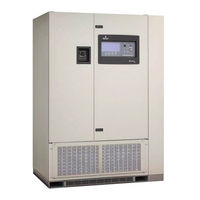Liebert SERIES 610 Manuals
Manuals and User Guides for Liebert SERIES 610. We have 4 Liebert SERIES 610 manuals available for free PDF download: Operation & Maintenance Manual, Installation Manual, User Manual
Liebert SERIES 610 Operation & Maintenance Manual (120 pages)
100-1000kVA, 60Hz Three Phase Multi-Module
Table of Contents
Advertisement
Liebert SERIES 610 Operation & Maintenance Manual (104 pages)
100-1000kVA, 60Hz Three Phase Single-Module
Brand: Liebert
|
Category: Power Supply
|
Size: 1 MB
Table of Contents
Liebert SERIES 610 Installation Manual (88 pages)
100-225kVA, 60Hz, Three Phase Multi-Module
Table of Contents
Advertisement
Liebert SERIES 610 User Manual (44 pages)
CONTINUOUS POWER-TIE CONFIGURATION Multi-Module UPS
Table of Contents
Advertisement



